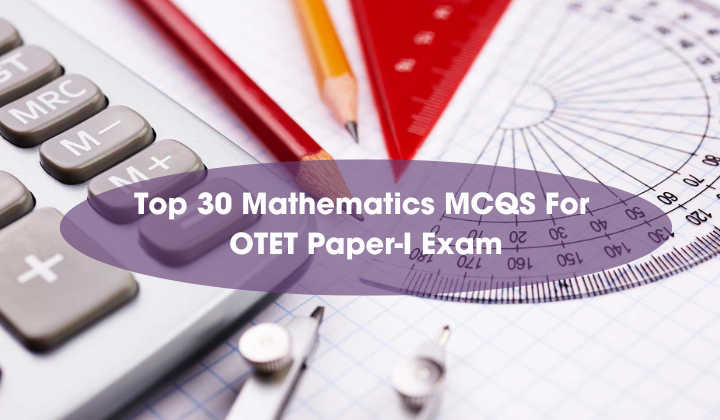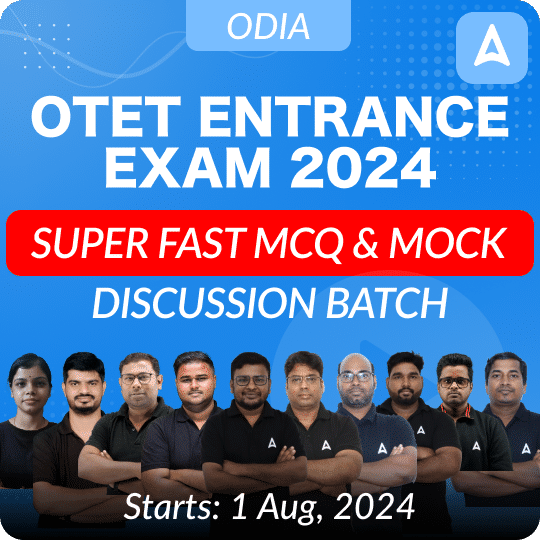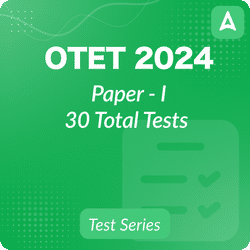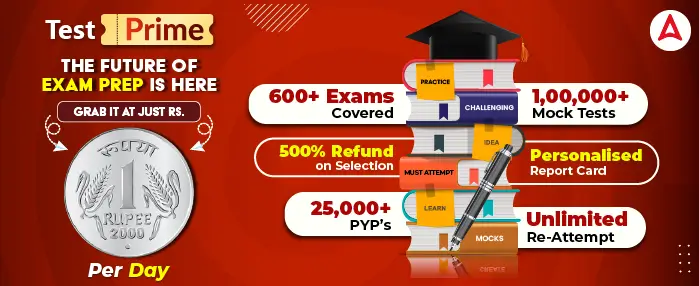Preparing for the Odisha Teacher Eligibility Test (OTET) Paper-I requires a strong grasp of mathematics concepts relevant to the secondary school curriculum. Here, we present a curated selection of 30 multiple-choice questions (MCQs) covering various topics in mathematics. These questions are designed to help you assess and reinforce your understanding in preparation for the exam.
Top 30 Mathematics MCQS For OTET Paper-I Exam
- What is in a math textbook?
(a) Specific objectives of teaching
(b) Teaching tools
(c) Teaching method
(d) Summary
Answer: (d) Summary - Which of the following is not a principle of mathematics textbook preparation?
(a) Student Center
(b) Flexible and relevant to daily life
(c) Coordinating with other textual topics
(d) Flexible text object
Answer: (d) Flexible text object - What skills of the student should be emphasized in the early stages of teaching mathematics in primary school?
(a) Number recognition and counting
(b) Multiplication and division of numbers
(c) Application of mathematical codes
(d) Measurement of height and weight
Answer: (a) Number recognition and counting - Which of the following is an indicator of optimal mathematical ability?
(a) Mathematical notation
(b) Solving Mathematical Problems
(c) Conversion of mathematical language into symbolic language
(d) Determining and correcting errors in the mathematical solution process
Answer: (b) Solving Mathematical Problems - A student is able to write numbers in ascending order. What ability does this indicate in the student?
(a) Recognizes big and small numbers
(b) Can distinguish big and small numbers
(c) Understands the sequence of big and small numbers
(d) Can write large and small numbers
Answer: (c) Understands the sequence of big and small numbers - A student draws different circles of different sizes and finds that the diameter of each circle touches the center point and the diameter of the circle is twice the radius. What method of mathematics does this refer to?
(a) Ride
(b) Descend
(c) Solution
(d) Synthesis
Answer: (a) Ride - Which of the following is a characteristic of mathematics teaching from the point of view of internal structure?
(a) Violator of disciplined disclosure
(b) Systematic and hierarchical organization of content
(c) Interaction of contents
(d) Above time
Answer: (d) Above time - Which methods are useful for geometrical reasoning proofs in higher grades?
(a) Ride
(b) Descend
(c) Analysis
(d) Problem solving
Answer: (c) Analysis - To celebrate Ganesh Puja, the teacher assigned some project work for the students. Which of the following is not related to project work?
(a) To decorate
(b) To collect donations
(c) Buying puja material
(d) Write a composition about Ganesh Puja
Answer: (d) Write a composition about Ganesh Puja - What is domina?
(a) A math learning tool
(b) A geometry box
(c) A mathematical process
(d) Name of a mathematician
Answer: (a) A math learning tool - In the below diagram, the distance of point P perpendicular to the Y axis is measured along which axis?
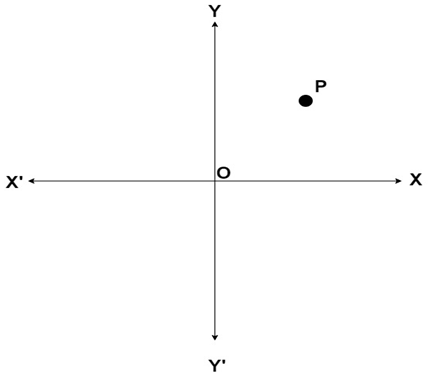
a) positive x
b) positive y
c) negative x
d) negative y
Answer: a
Explanation: As shown in the diagram, point P is located on the right-hand side of the Y axis. The right-hand side of the Y axis corresponds to the positive X axis, so the distance of point P perpendicular to the Y axis is measured along the positive X axis.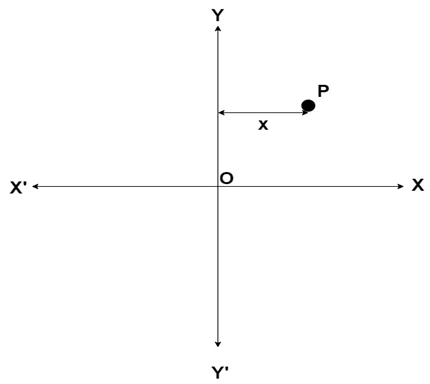
- Which of the following are positive directions?
a) OX’ and OY’
b) OX and OY’
c) OX’ and OY
d) OX and OY
Answer: d
Explanation: Positive numbers lie on the directions OX and OY, while negative numbers lie on the directions OX’ and OY’. Therefore, the positive directions are OX and OY.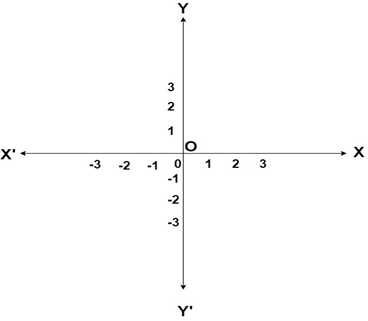
- If a point is in the 2nd quadrant, then it is in which form?
a) (+, +)
b) (+, -)
c) (-, +)
d) (-, -)
Answer: c
Explanation: In the 2nd quadrant, any point will be in the form (-, +) since the 2nd quadrant is enclosed by the negative X axis and positive Y axis. Points in the 1st quadrant are in the form (+, +), in the 3rd quadrant in the form (-, -), and in the 4th quadrant in the form (+, -).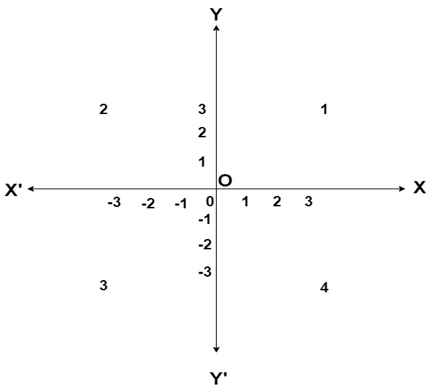
- From the given diagram, what are the coordinates of point P?
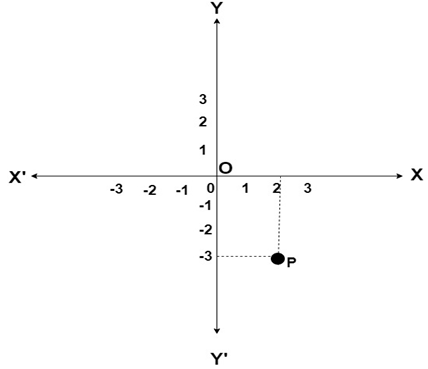
a) (2, -3)
b) (-2, 3)
c) (2, 3)
d) (3, 2)
Answer: a
Explanation: The diagram shows that the distance of point P is 2 from the Y axis in the positive X axis direction and 3 from the X axis in the negative Y axis direction. Therefore, the coordinates of point P are (2, -3). - Why is coordinate geometry used?
a) To find the square root of a number
b) To locate a point in a plane precisely
c) To create different shapes
d) To multiply numbers
Answer: b
Explanation: Coordinate geometry is used to locate any point in a plane precisely by using its distances from the X and Y axes. Knowing both distances allows for accurate placement of the point in the plane.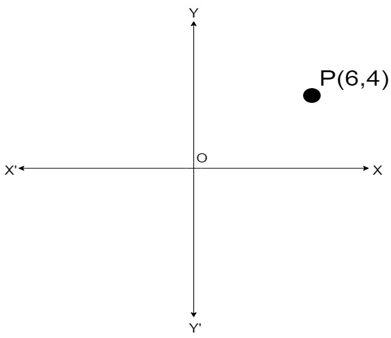
- A triangle has __________ vertices.
a) one
b) two
c) three
d) four
Answer: c
Explanation: A triangle has three vertices. In the diagram of triangle ABC, the vertices are A, B, and C. The triangle also has three edges (AB, BC, AC) and three angles (∠A, ∠B, ∠C).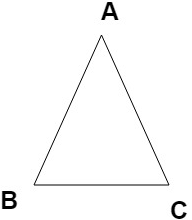
- Which one is true if triangle ABC is congruent to triangle PQR?
a) AB = PQ
b) AB = QR
c) BC = QR
d) ∠A = ∠Q
Answer: a
Explanation: If triangles ABC and PQR are congruent, AB = PQ, BC = QR, and AC = PR. Also, ∠A = ∠P, ∠B = ∠Q, and ∠C = ∠R. The vertices correspond as follows: A = P, B = Q, and C = R. - From the diagram given below, which is true for two triangles?
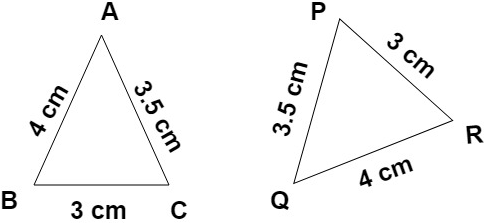
a) Triangle ABC is congruent to triangle PQR
b) Triangle ABC is congruent to triangle QPR
c) Triangle ABC is congruent to triangle QRP
d) Triangle ABC is congruent to triangle RPQ
Answer: c
Explanation: Based on the diagram, AB corresponds to QR, BC to RP, and CA to PQ. Therefore, triangle ABC is congruent to triangle QRP. - Find the value of x.
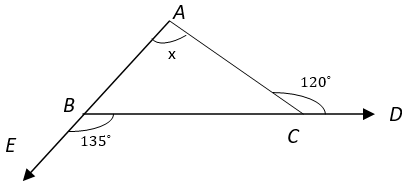
a) 90°
b) 75°
c) 135°
d) 45°
Answer: b
Explanation:
From the figure, ∠EBC + ∠ABC = 180° (Linear Pair)
⇒ 135° + ∠ABC = 180°
⇒ ∠ABC = 45°
Also, ∠ACB + ∠ACD = 180° (Linear Pair)
⇒ 120° + ∠ACB = 180°
⇒ ∠ACB = 60°
In ∆ABC, ∠BAC + ∠ABC + ∠ACB = 180° (Angle Sum property of triangle)
⇒ 45° + x + 60° = 180°
⇒ x = 180° – 105°
⇒ x = 75° - Which of the following relations between x and y is correct?
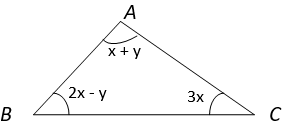
a) x + y = 45°
b) x – y = 180°
c) 3x + y = 90°
d) 3x – y = 90°
Answer: d
Explanation:
In ∆ABC, ∠BAC + ∠ABC + ∠ACB = 180° (Angle Sum property of triangle)
⇒ (x + y) + (2x – y) + (3x) = 180°
⇒ 6x – 2y = 180°
⇒ 3x – y = 90° - Find the greatest number that will divide 43, 91, and 183 so as to leave the same remainder in each case.
(a) 4
(b) 7
(c) 9
(d) 13
Answer: (a)
Explanation:
Required number = H.C.F. of (91 – 43), (183 – 91), and (183 – 43)
= H.C.F. of 48, 92, and 140 = 4. - The H.C.F. of two numbers is 23 and the other two factors of their L.C.M. are 13 and 14. The larger of the two numbers is:
(a) 276
(b) 299
(c) 322
(d) 345
Answer: (c)
Explanation:
Clearly, the numbers are (23 × 13) and (23 × 14).
Larger number = (23 × 14) = 322. - Six bells commence tolling together and toll at intervals of 2, 4, 6, 8, 10, and 12 seconds respectively. In 30 minutes, how many times do they toll together?
(a) 4
(b) 10
(c) 15
(d) 16
Answer: (d)
Explanation:
L.C.M. of 2, 4, 6, 8, 10, 12 is 120.
So, the bells will toll together every 120 seconds (2 minutes).
In 30 minutes, they will toll together
30/2+1=16 times. - Let N be the greatest number that will divide 1305, 4665, and 6905, leaving the same remainder in each case. Then the sum of the digits in N is:
(a) 4
(b) 5
(c) 6
(d) 8
Answer: (a)
Explanation:
N = H.C.F. of (4665 – 1305), (6905 – 4665), and (6905 – 1305)
= H.C.F. of 3360, 2240, and 5600 = 1120.
Sum of digits in N = (1 + 1 + 2 + 0) = 4. - The greatest number of four digits which is divisible by 15, 25, 40, and 75 is:
(a) 9000
(b) 9400
(c) 9600
(d) 9800
Answer: (c)
Explanation:
Greatest number of 4-digits is 9999.
L.C.M. of 15, 25, 40, and 75 is 600.
On dividing 9999 by 600, the remainder is 399.
Required number = 9999 – 399 = 9600. - Irrational numbers are denoted by:
a) N
b) Z
c) Q
d) S
Answer: d
Explanation: As per the conventional notation, irrational numbers are denoted by ‘S’. N, Z, and Q are used for Natural numbers, Integers, and Rational numbers respectively. - Real numbers are denoted by which letter?
a) R
b) W
c) Q
d) N
Answer: a
Explanation: As per the conventional notation, real numbers are denoted by ‘R’. W, Q, and N are used for Whole numbers, Rational numbers, and Natural numbers respectively. - All irrational numbers are real numbers.
a) True
b) False
Answer: a
Explanation: Real numbers comprise both rational numbers and irrational numbers. {Real numbers} = {Rational numbers} + {Irrational numbers}. Hence, all irrational numbers are real numbers. - How many real numbers are there between 3 and 8 (including 3 and 8)?
a) Six
b) Four
c) Infinite
d) Five
Answer: c
Explanation: There are infinite numbers between 3 and 8 like 3.45, 5.56, 5.95, 6, 7.41, and so on. All these numbers are real according to the definition of real numbers {Real numbers} = {Rational numbers} + {Irrational numbers}. Hence, there are infinite real numbers between any two integers. - 0.3454545…..=_____________
a) 345/1000
b) 350/995
c) 355/900
d) 342/990
Answer: d
Explanation:
Let 0.3454545… = x
Then, 100x = 34.5454545…
100x = 34.2 + 0.3454545…
100x = 34.2 + x
99x = 34.2
x = 34.2/99
x = 342/990.

